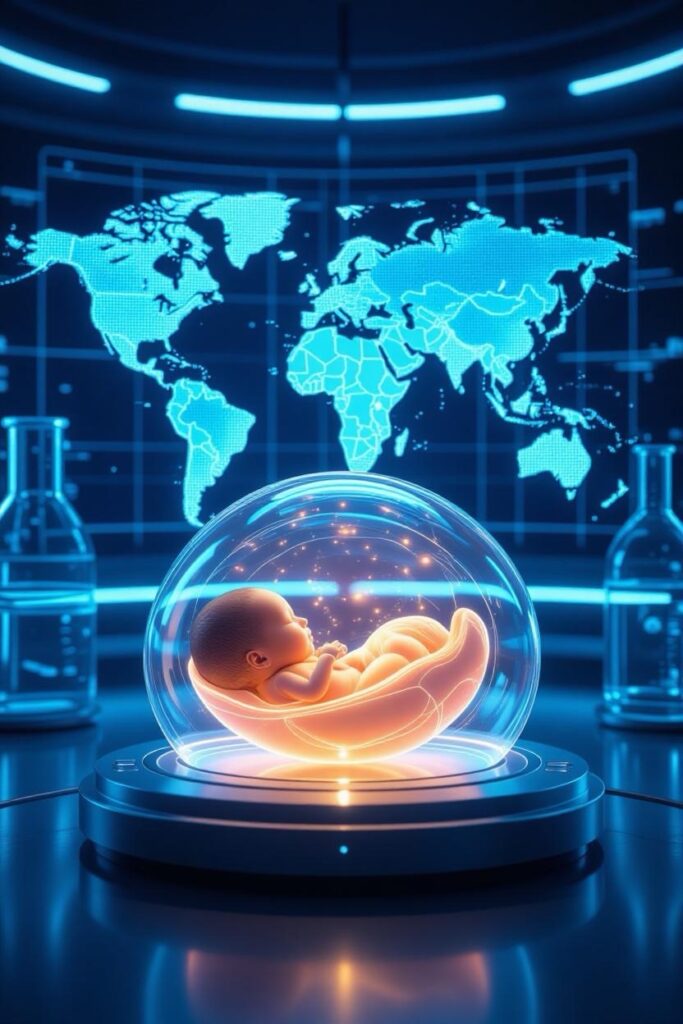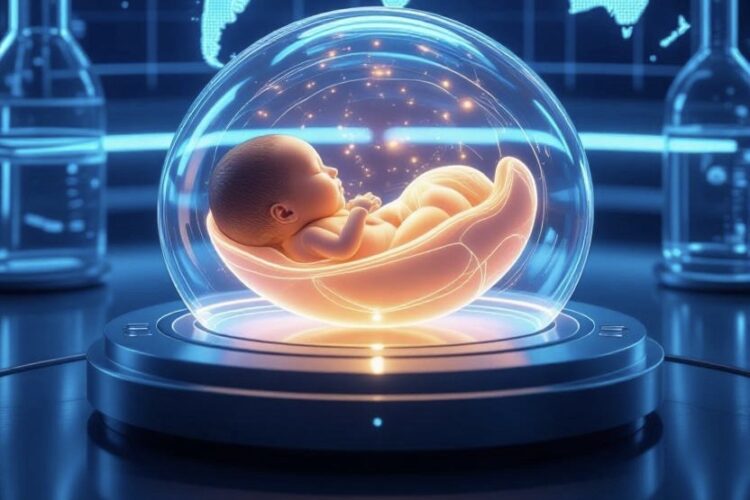Artificial womb technology, or ectogenesis, could transform reproduction by growing babies in biobags, addressing infertility, high-risk pregnancies, and population decline. This biotechnology mimics natural wombs, supporting premature infants and potentially enabling full-term lab-grown babies. It tackles age-related fertility issues, like ovarian aging, allowing older adults to conceive via in vitro fertilization and artificial placentas. By reducing pregnancy risks, it may boost birth rates, countering aging crises in countries like Japan. However, economic and cultural factors limit population explosion risks. Ethical concerns, including embryo rights and bodily autonomy, spark debate, while accessibility remains a challenge. Artificial wombs could stabilize demographics and redefine family planning, but technical and regulatory hurdles persist. This innovation promises a balanced future if managed carefully.
Long Version
Will Lab-Grown Babies Explode Populations and End Aging Crises?
In an era marked by plummeting birth rates and escalating concerns over population decline, the advent of lab-grown babies through artificial womb technology emerges as a provocative solution. This biotechnology, encompassing ectogenesis and synthetic reproduction, promises to revolutionize reproduction by decoupling pregnancy from the human body. Imagine embryos nurtured in biobags or artificial uteruses, bypassing traditional gestation to address infertility, high-risk pregnancies, and even demographic crises. But could this innovation trigger a baby boom, avert population collapse, and mitigate the aging crisis gripping global society? As demographics shift with aging populations straining resources, artificial womb technology offers tantalizing insights into reshaping family planning, fertility, and the very fabric of human reproduction.
The Current Landscape of Artificial Womb Technology
Artificial wombs represent a leap in biotechnology, evolving from neonatal incubators to sophisticated systems mimicking the natural uterus. At the forefront, researchers have developed systems designed to support premature births by reducing health risks for extremely preterm infants. This involves biobags—fluid-filled sacs that simulate amniotic environments, allowing fetuses to develop outside the body from as early as 23 weeks gestational age.
In 2025, progress accelerates: a Chinese firm has announced plans for a humanoid robot equipped with an artificial womb, aiming for a prototype by 2026, while Dutch researchers continue refining ectogestation devices with multimillion-euro grants. These advancements build on embryo culture techniques integrated with in vitro fertilization, where embryos are cultivated externally before transfer to artificial placentas or growth pods. Yet, full ectogenesis—from conception to birth in an artificial uterus—remains in early stages, focused primarily on saving lives from premature births rather than routine reproduction. Recent reviews highlight ongoing developments, including artificial placenta systems that sustain fetal circulation without maternal involvement, though human clinical trials are nascent due to technical hurdles.
This technology targets critical issues like infertility and age-related fertility decline, where ovarian aging and menopause limit natural conception. By enabling ectogestation, artificial womb technology could extend reproductive windows, allowing older individuals to pursue parenthood without the physical toll of pregnancy.
Revolutionizing Reproduction and Fertility
Lab-grown babies could transform how we approach fertility and pregnancy. Traditional barriers, such as bodily autonomy constraints during gestation, high-risk pregnancies, and premature births, might diminish as artificial wombs provide safer alternatives. For instance, women facing complications could opt for embryo transfer to biobags, reducing maternal risks while ensuring fetal viability. In vitro fertilization, already a cornerstone of assisted reproduction, would integrate seamlessly, with genetically engineered embryos cultured in synthetic environments to optimize outcomes.
Infertility affects millions globally, often linked to age-related fertility decline and post-reproductive lifespan challenges. Artificial womb technology offers hope by extending gestational age support, potentially alleviating the emotional and physical burdens of repeated in vitro fertilization cycles or surrogacy. In high-risk scenarios, such as those involving premature births, these systems could mimic natural womb conditions, fostering development without the vulnerabilities of traditional incubation. Moreover, synthetic reproduction could democratize parenthood, enabling same-sex couples or single individuals to bypass biological limitations through embryo culture and artificial placentas.
However, adoption hinges on accessibility. While promising for addressing child care and family planning by separating reproduction from career interruptions, real-world implementation requires overcoming scalability issues in growth pods and artificial uterus designs.
Demographic Implications: From Decline to Potential Growth
Global demographics paint a stark picture: birth rates are falling, leading to population decline in many regions, while demographic momentum from past baby booms fades. In countries like Japan and China, low fertility exacerbates aging crises, with projections showing shrinking workforces and strained social systems. Could lab-grown babies reverse this?
Ectogenesis might boost population growth by lowering reproduction barriers. By easing the physical and economic costs of pregnancy, it could encourage more births, countering demographic crises. In scenarios where women delay childbearing due to career demands, artificial womb technology allows for later-life reproduction without fertility loss from ovarian aging. Studies suggest assisted reproductive technologies like in vitro fertilization already compensate for delayed parenthood, potentially increasing birth rates by 10-20% in aging populations. For nations facing population collapse, such as South Korea or Italy, synthetic reproduction could facilitate large-scale embryo culture, fostering a new baby boom.
Yet, skeptics argue it won’t explode populations. Infertility isn’t the primary driver of low birth rates; economic pressures, child care costs, and lifestyle choices are. Even with artificial womb technology, global society might not see unchecked growth, as cultural shifts toward smaller families persist. Instead, it could stabilize demographics, preventing collapse by enabling precise family planning.
Tackling the Aging Crisis Head-On
The aging crisis—characterized by extended post-reproductive lifespans and fewer young people supporting the elderly—threatens economic stability worldwide. Artificial womb technology intersects here by addressing age-related fertility decline, where menopause and ovarian aging curtail natural reproduction. By integrating with in vitro fertilization, it allows older adults to conceive viable embryos for ectogestation, effectively extending fertile years.
In China, policies subsidizing assisted reproductive technologies aim to reverse population decline, with artificial wombs potentially amplifying this by supporting high-volume reproduction. Projections indicate assisted reproductive technologies could offset delayed childbearing, boosting birth rates among aging demographics and easing the burden on healthcare systems. This might end the aging crisis by replenishing younger cohorts, sustaining demographic momentum, and reducing dependency ratios.
Risks of Population Explosion or Unintended Consequences
While artificial womb technology could avert population collapse, it raises specters of explosion if misused. Genetically engineered embryos in growth pods might enable mass production, altering global society dynamics. However, ethical safeguards and resource limits would likely prevent runaway growth.
Ethical and Societal Dimensions
Ethics loom large in artificial womb technology debates. Bodily autonomy gains as women escape pregnancy’s risks, but concerns arise over embryo rights, viability redefinitions, and abortion implications—where ectogestation might allow “termination” without death. Feminist views diverge: some see liberation from reproductive burdens, others fear detachment from motherhood.
Socially, it challenges family planning and child care norms, potentially creating psychological harms for lab-grown children or privacy invasions. Legal frameworks must evolve to address designer babies and equity in access, ensuring artificial womb technology benefits all without exacerbating inequalities.
Looking Ahead: A Transformative Future?
As artificial womb technology advances toward complete ectogenesis, integrating artificial placentas and growth pods with in vitro fertilization, it could redefine reproduction. Yet, realization depends on overcoming technical, ethical, and regulatory barriers.
In conclusion, lab-grown babies hold potential to stabilize populations and alleviate aging crises by enhancing fertility options and reducing reproductive risks. However, they are unlikely to cause an explosion without broader societal shifts. Instead, artificial womb technology could foster a balanced demographic future, provided we navigate its profound implications with care. This biotechnology isn’t just about creating life—it’s about reimagining our global society’s trajectory.

Hashtags For Social Media
#LabGrownBabies #ArtificialWomb #Ectogenesis #SyntheticReproduction #BiotechFuture #AgingCrisis #PopulationDecline #FutureOfFertility #ReproductiveTech #Bioethics #EctoLife #ArtificialUterus #FertilityInnovation #DemographicShift #AntiAging #Biotechnology #ScienceTech #MolecularBiology #Genetics #InfertilitySolutions #PrematureBirths #OvarianAging #FamilyPlanning #GlobalDemographics #BabyBoom #PopulationGrowth #EthicalTech #LabGrownLife #Ectogestation #FutureParenthood
Related Questions, Words, Phrases
will lab-grown babies solve population decline? | how could artificial wombs end the aging crisis? | lab-grown babies and population explosion risks | can ectogenesis fix global fertility issues? | impact of synthetic reproduction on demographics | artificial uterus technology for aging populations | will biobags trigger a new baby boom? | lab-grown babies: solution to infertility and aging? | how artificial wombs might prevent population collapse | ectogestation and its effects on birth rates | could growth pods address age-related fertility decline? | lab-grown babies ending menopause barriers | synthetic reproduction revolutionizing family planning | artificial placenta tech combating demographic crises | will lab-grown infants stabilize global society? | high-risk pregnancies solved by artificial wombs? | embryo culture and population growth potential | in vitro fertilization with ectogenesis for older parents | biobags as answer to premature births and aging | how lab-grown babies could boost fertility rates | artificial womb technology ethics in population control | genetically engineered embryos and demographic momentum | ovarian aging overcome by synthetic gestation? | lab-grown babies: averting the child care crisis? | impact of ectogestation on post-reproductive lifespan | could artificial uteruses cause unchecked population growth? | lab-grown reproduction for same-sex couples and demographics | artificial womb prototypes tackling infertility worldwide | how biobags might reshape bodily autonomy and birth rates | ectogenesis ending the aging crisis in japan and china? | synthetic babies and risks of population explosion | artificial placenta systems for high-volume reproduction | lab-grown embryos: key to preventing demographic collapse | will growth pods democratize parenthood amid aging populations? | comprehensive guide to lab-grown babies and fertility solutions






